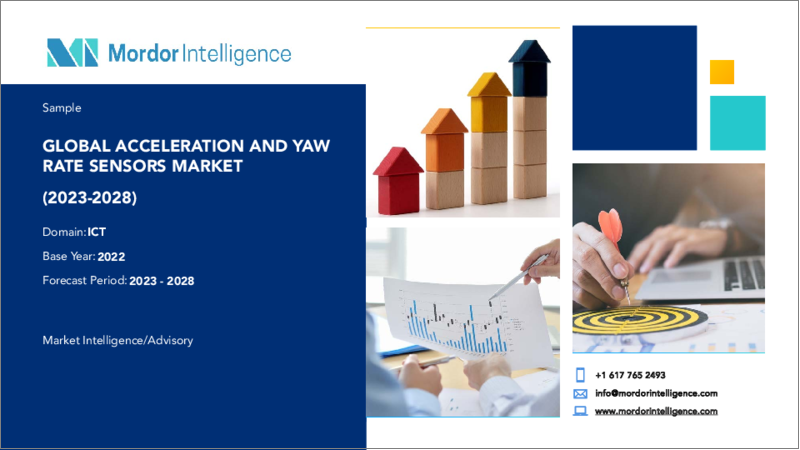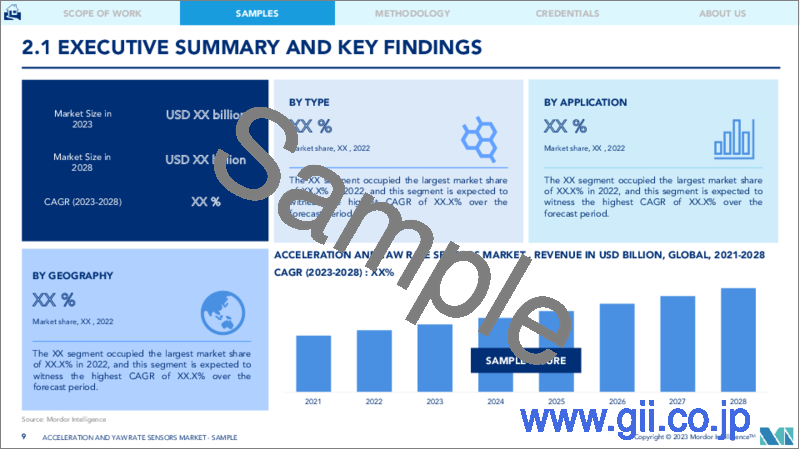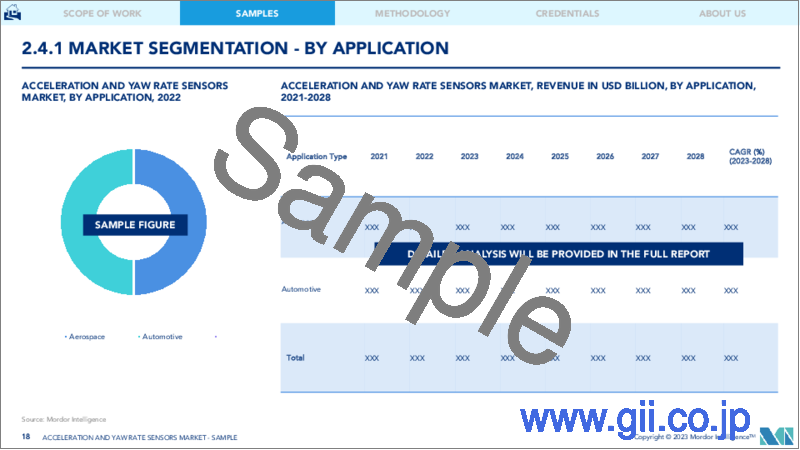|
|
市場調査レポート
商品コード
1196865
加速度センサーおよびヨーレートセンサーの世界市場-成長、動向、予測(2023年~2028年)Global Acceleration and Yaw Rate Sensors Market-Growth, Trends, and Forecasts (2023 - 2028) |
||||||
|
● お客様のご希望に応じて、既存データの加工や未掲載情報(例:国別セグメント)の追加などの対応が可能です。 詳細はお問い合わせください。 |
|||||||
| 加速度センサーおよびヨーレートセンサーの世界市場-成長、動向、予測(2023年~2028年) |
|
出版日: 2023年01月23日
発行: Mordor Intelligence
ページ情報: 英文 100 Pages
納期: 2~3営業日
|
- 全表示
- 概要
- 目次
加速度センサーおよびヨーレートセンサーの世界市場は、予測期間(2022-2027年)に11.68%のCAGRで成長すると予想されています。
ヨーレートセンサーは、車両の垂直軸周りの角運動を検出するジャイロスコープガジェットです。多くの場合、出力は1秒間に何度、または1秒間に何ラジアンかで表されます。ヨーレートに関連するスリップ角とは、車両の走行方向と実走行方向の成す角のことです。この値の算出には、コリオリ効果を利用します。コリオリ効果により、正確な読み取りと結果が得られます。したがって、市場の優位性を維持すると予測されます。コリオリ加速度は、マイクロメカニカルタイプの振動素子上のマイクロメカニカルキャプチャ加速度センサーを通して感知されます。加速度は、ヨーレートと振動速度の積に比例し、電子的に維持されます。
主なハイライト
- 都市化の進展や自動化需要の高まりにより、多くの最終用途分野で様々な安全センサーが採用されています。自動車や航空機には、さまざまなセンサーが採用されています。これらのセンサは、正確さと使いやすさを提供しながら、車両の安全性を確保します。ヨー角速度センサーは、自動車で一般的に使用されているジャイロセンサー装置で、車両の垂直軸周りの角速度を測定するものです。
- ヨーレートセンサーは、安全性を優先するため、車両のエレクトロニック・スタビリティ・コントロールと統合されてきました。中国やインドなどの新興国を中心に乗用車メーカーが増加していることが、ヨーレートセンサの需要や売上を押し上げ、市場の成長を後押ししていると分析されます。
- 車載用センサーの需要を押し上げる主な要因の1つは、自律走行です。ほとんどの車載用センサーは、自動車市場全体と一体となって増加しています。車載用センサーの需要増は、ADASやADシステムの普及に起因しています。
- 自動車用センサーのアフターマーケットが未発達であるため、自動車用センサー業界はOEMによって支配されています。産業用センサやホームオートメーション用エレクトロニクスなど、その他の事業分野は、市場成長の原動力としてアフターマーケットに大きく依存しています。しかし、自動車用センサの技術標準のほとんどは、自動車メーカーまたはティア1サプライヤーによって提供されており、これが自動車用センサの商品化における課題の主な理由となっています。
- COVID-19は、生産の停止やサプライチェーンの混乱など、自動車部門に大きな影響を与えました。しかし、自律走行車や電気自動車の開発が大幅に進み、先進的なセンサのニーズが高まっていることから、予測期間中に加速度センサーおよびヨーレートセンサー市場の需要が高まると分析されています。
加速度センサーおよびヨーレートセンサーの市場動向
予測期間中、自動車セグメントが最も高い成長率を示すと分析されています。
- 自動車業界では、乗客の安全基準がセンサーの設置や機能の背景にある考え方を後押しし、その情報はESC(電子制御システム)に送られ、ヨーモーメントを管理するために使用されます。センサーは主に関連システムの信頼性を向上させるために採用され、メーカーはこの特性をマーケティング上の保証として活用しています。このようなアプリケーションの重要な要素と、製品の入手が比較的簡単であることを考慮すると、ヨーレートセンサの需要は予測期間中に増加し、世界のメーカーに大きな成長の可能性をもたらすと予想されます。
- 近年、自動車需要の拡大に伴い、自動車産業の革新と開発は大きく進化しています。先進国および新興国の自動車アフターマーケットにおいては、自動化時代の始まり以来、より急速に進歩しています。このことは、ヨーレートセンサをはじめとする最新の自動車内システムの採用を促し、ヨーレートセンサ市場の拡大をもたらしています。OEMは、アフターマーケットに加えて、車両の安定性の面で最適な信頼性を提供するために、車両にヨーレートセンサーを組み込むようになりました。
- 2022年2月、BMWはBMW iXとBMW i4 M50にBMWの全電動式BMW xDriveシステムを配備しました。全電動式のBMW xDriveシステムは、驚くべき駆動力の変換を可能にします。駆動トルクは正確に配分されなければならないです。これは、DSC(ダイナミック・スタビリティ・コントロール)とアクチュエーター関連のホイール・スリップ・リミットの設計、およびCCU(コンバインド・チャージング・ユニット)を統合することで実現します。CCUは、初めて充電と駆動電子機器の両方を包含する高度に統合された機能群です。DSCは、BMW xDriveの電動システムが機能するためのパラメータを決定します。車両の車輪速度、ステアリング角、走行速度、縦・横加速度、ヨーレートを常時監視しています。
- 三菱自動車は、「アウトランダーPHEV」モデルを2021年10月に発売し、12月に販売を開始しました。日本では2021年12月に販売を開始し、2022年前半にオーストラリアとニュージーランド、2022年後半に北米で販売を開始しました。車両運動統合制御システム「S-AWC(Super-All Wheel Control)」は、前と後ろに駆動モーターを配置したツインモーター4WDシステムをベースに、後輪に新たにブレーキAYC(Active Yaw Control)機能を搭載しています。
アジア太平洋地域が最も速い成長率を記録する見込み
- アジア太平洋地域は、自動車製造の大幅な増加により、予測期間中に最も高いCAGRで成長すると分析されています。また、この地域の政府は、自動車の排出量を削減するためにEVの使用を促進しています。これは、所定の市場の成長にプラスの影響を与えることが期待されます。
- アジア太平洋地域における自動車の電動化と高い導入率は、予測期間中の市場成長率に貢献すると分析されています。例えば、Tata Motorsは2021年3月にインドでT-Seriesスマートトラックを発売し、都市型モビリティのニーズの高まりに対応しています。これらの小型商用・中間トラックは、3つのタイプで提供されます。
- NITI AayogとRocky Mountain Institute(RMI)が述べているように、インドのEV金融分野はINR.3.7 lakh croreに達すると予想されます。2030年までに3.7 lakh croreに達する見込みです。India Energy Storage Allianceによると、インドのEV産業は2026年までにCAGR36%で成長すると予想されています。大手自動車メーカーはここ数カ月、需要の高まりに対応するため、事業のさまざまな部分への投資を増やしています。
- 現代自動車は2021年12月、インドでの研究開発に4,000億インドルピーを投資し、2028年までに6台の電気自動車を発売する計画を発表しました。
- Tata Motorsは2021年10月、プライベート・エクイティ企業のTPGとアブダビのADQが同社の電気自動車部門に7,500クローネを投資することに合意したと表明しました。
加速度センサーおよびヨーレートセンサー市場の競合企業分析
加速度センサーおよびヨーレートセンサーの世界市場で事業を展開する主な企業は、Epson Europe Electronics GmbH、Robert Bosch GmbH、ST Microelectronics Continental AG、Baumer Holding AG、DIS Sensors BV、InnaLabs、Silicon Sensing Systems Ltd、Xsens Technologies B.V、Diversified Technical Systems, Inc、MEMSIC Semiconductor(Tianjin)、CTS corporationなどです。
- 2022年6月-Silicon Sensing Systems Ltdは、6月のSensors Convergeに、小型で低コストのナビゲーションおよびポインティングジャイロからコンパクトで戦術的な9自由度の慣性計測ユニット(IMU)まで、オールシリコンMEMS慣性センサとシステムの全ポートフォリオを出展します。
その他の特典
- エクセル形式の市場予測(ME)シート
- 3ヶ月間のアナリストサポート
目次
第1章 イントロダクション
- 調査の前提条件と市場の定義
- 調査対象範囲
第2章 調査手法
第3章 エグゼクティブサマリー
第4章 マーケットインサイト
- 市場概要
- ポーターのファイブフォース分析
- 買い手/消費者の交渉力
- 供給企業の交渉力
- 新規参入業者の脅威
- 代替品の脅威
- 競争企業間の敵対関係
- コビット-19の市場影響度評価
第5章 市場力学
- 市場促進要因
- 自動車の安全性、セキュリティ、快適性に対する消費者の要求の高まり
- GHG排出量削減のための代替燃料車への消費者の傾斜の高まり
- 市場抑制要因
- 新興国における車載用センサーのアフターマーケットが未発達
第6章 市場セグメンテーション
- タイプ別
- ピエゾ式
- マイクロメカニカルタイプ
- アプリケーション別
- 航空宇宙
- 自動車
- 乗用車
- 小型商用車
- 大型商用車
- 地域別
- 北米
- 欧州
- アジア太平洋地域
- ラテンアメリカ
- 中東地域
第7章 競合情勢
- 企業プロファイル
- Epson Europe Electronics GmbH
- Robert Bosch GmbH
- ST Microelectronics
- Continental AG
- Baumer Holding AG
- DIS Sensors BV
- Silicon Sensing Systems Ltd
- Xsens Technologies B.V.
- Diversified Technical Systems, Inc.
- MEMSIC Semiconductor(Tianjin)Co., Ltd.
- CTS corporation
第8章 投資分析
第9章 今後の動向
The global Acceleration and Yaw Rate Sensors market is expected to grow at a CAGR of 11.68% over the forecast period (2022-2027). A yaw rate sensor is a gyroscope gadget that detects a vehicle's angular motion around its vertical axis. In most cases, the output is expressed in degrees per second or radians per second. The slip angle, related to the yaw rate, is the angle formed between the vehicle's driving and real direction. The Coriolis Effect is used to calculate this value. The Coriolis effect provides precise readings and results. Thus it is projected to maintain its market dominance. Coriolis acceleration is sensed through a micromechanical capture acceleration sensor on the oscillating element in the micromechanical type. The acceleration is proportional to the product of the yaw rate and the oscillation speed, which is maintained electronically.
Key Highlights
- The employment of various safety sensors in many end-use sectors has been driven by the expanding urbanization process and the huge demand for automation. Cars and aircraft employ a variety of sensors. These sensors ensure vehicle safety while providing accuracy and ease of use. The yaw angular velocity sensor is a gyroscope device commonly used in automobiles that determines the vehicle's angular velocity around its vertical axis.
- Yaw rate sensors have been integrated with the vehicle's electronic stability control because safety is a priority. The growing number of passenger car manufacturers, particularly in emerging markets such as China and India, is analyzed to boost demand for and sales of yaw rate sensors, boosting the market's growth.
- One of the primary factors boosting demand for automotive sensors is autonomous driving. Most automotive sensors are increasing in unison with the total automotive market. The increased demand for automotive sensors is due to the widespread use of ADAS and AD systems.
- Because of the underdeveloped aftermarket for automobile sensors, the automotive sensors industry is dominated by OEMs. Other business categories, such as industrial sensors and home automation electronics, rely heavily on the aftermarket to drive market growth. However, most technical standards for automotive sensors are provided by the car manufacturer or a tier 1 supplier, which is the primary reason for the challenge in commercializing automotive sensors.
- COVID-19 has significantly impacted the automotive sector with the halt in production and disruption in the supply chains. However, the significant boost in the development of autonomous and electric vehicles and the need for advanced sensors is analyzed to bolster the demand for the acceleration and yaw rate sensors market during the forecast period.
Acceleration & Yaw Rate Sensors Market Trends
Automotive Segment is analyzed to grow at highest rate during the forecast period
- Passenger safety standards drive the notion behind sensor installation or function in the automotive industry, and its information is sent to the ESC (electronic control system) to manage the yaw moment. Sensors are primarily employed to improve the reliability of associated systems, and manufacturers utilize this attribute as a marketing assurance. Considering these crucial elements of the application and the relative simplicity of product availability, demand for yaw rate sensors is expected to rise during the forecast period, resulting in significant growth possibilities for global manufacturers.
- As the demand for automobiles has grown in recent years, the automotive industries' innovation and development have evolved significantly. Automotive aftermarkets in advanced and emerging economies have progressed more rapidly since the beginning of the automation era. This encourages the use of modern internal systems in automobiles, such as yaw rate sensors, and thus the expansion of the yaw rate sensor market. OEMs have begun to integrate yaw rate sensors in vehicles, in addition to the aftermarket, to provide optimum confidence in terms of vehicle stability.
- In February 2022, BMW deployed BMW's all-electric BMW xDrive system in BMW iX and BMW i4 M50. The all-electric BMW xDrive system enables remarkable drive power to be transformed. The drive torque must be distributed precisely. This is achieved by integrating the DSC (Dynamic Stability Control) with the design of the actuator-related wheel slip limits and the Combined Charging Unit (CCU), a highly integrated range of functions that, for the first time, encompasses both charging and drive electronics. The DSC determines the parameters within which the electric BMW xDrive system can function. The vehicle's wheel speeds, steering angle, driving speed, longitudinal and lateral acceleration, and yaw rate are all constantly monitored.
- Mitsubishi Motors launched the Outlander PHEV model in October 2021, with sales in December. Sales began in December 2021 in Japan, with Australia and New Zealand following in the first half of 2022 and North America following in the second half of 2022. The S-AWC (Super-All Wheel Control) integrated vehicle dynamics control system has a new brake AYC (Active Yaw Control) function for the rear wheels, based on a twin-motor 4WD system with one drive motor in front and another in the back.
Asia Pacific Region is Expected to Register the Fastest Growth Rate
- Asia Pacific is analyzed to grow at the highest CAGR during the forecast period due to the significant automotive manufacturing increase. The government in this region is also promoting the use of EVs to reduce vehicular emissions. This is expected to influence the given market's growth positively.
- The electrification of the vehicles and the higher adoption rates in the Asia-pacific region is analyzed to contribute to the market growth rate during the forecast period. For instance, Tata Motors launched the T-Series smart trucks in India in March 2021 to address the increased need for urban mobility. These light commercial and intermediate trucks are offered in three different types.
- As NITI Aayog and Rocky Mountain Institute (RMI) stated, India's EV finance sector is expected to reach INR. 3.7 lakh crore by 2030. According to the India Energy Storage Alliance, the EV industry in India is expected to grow at a CAGR of 36% by 2026. Major automakers have increased their investments in various parts of the business to meet rising demand in recent months.
- Hyundai announced plans to invest INR 4,000 crores in R&D in India in December 2021 to launch six electric vehicles by 2028.
- Tata Motors stated in October 2021 that private equity firm TPG and Abu Dhabi's ADQ had agreed to invest INR 7,500 crore in its electric vehicle sector.
Acceleration & Yaw Rate Sensors Market Competitor Analysis
Major players operating in the global Acceleration and Yaw Rate Sensors market include Epson Europe Electronics GmbH, Robert Bosch GmbH, ST Microelectronics Continental AG, Baumer Holding AG, DIS Sensors BV, InnaLabs, Silicon Sensing Systems Ltd, Xsens Technologies B.V., Diversified Technical Systems, Inc., MEMSIC Semiconductor (Tianjin) Co., Ltd., CTS corporation among others.
- June 2022- Silicon Sensing Systems Ltd is bringing its whole portfolio of all-silicon MEMS inertial sensors and systems to Sensors Converge in June, from tiny, low-cost navigation and pointing gyros to compact, tactical grade 9 degree of freedom inertial measurement units (IMUs).
Additional Benefits:
- The market estimate (ME) sheet in Excel format
- 3 months of analyst support
TABLE OF CONTENTS
1 INTRODUCTION
- 1.1 Study Assumptions and Market Definitions
- 1.2 Scope of the Study
2 RESEARCH METHODOLOGY
3 EXECUTIVE SUMMARY
4 MARKET INSIGHTS
- 4.1 Market Overview
- 4.2 Porter's Five Forces Analysis
- 4.2.1 Bargaining Power of Buyers/Consumers
- 4.2.2 Bargaining Power of Suppliers
- 4.2.3 Threat of New Entrants
- 4.2.4 Threat of Substitute Products
- 4.2.5 Intensity of Competitive Rivalry
- 4.3 Assessment of the Impact of COVID -19 on the Market
5 MARKET DYNAMICS
- 5.1 Market Drivers
- 5.1.1 Surging consumer demand for vehicle safety, security, and comfort
- 5.1.2 Growing inclination of consumers toward alternative fuel vehicles to reduce GHG emissions
- 5.2 Market Restraints
- 5.2.1 Underdeveloped aftermarket for automotive sensors in emerging economies
6 MARKET SEGMENTATION
- 6.1 By Type
- 6.1.1 Piezoelectric Type
- 6.1.2 Micromechanical Type
- 6.2 By Application
- 6.2.1 Aerospace
- 6.2.2 Automotive
- 6.2.2.1 Passenger Cars
- 6.2.2.2 Light Commercial Vehicles
- 6.2.2.3 Heavy Commercial Vehicles
- 6.3 Geography
- 6.3.1 North America
- 6.3.2 Europe
- 6.3.3 Asia-Pacific
- 6.3.4 Latin America
- 6.3.5 Middle-East
7 COMPETITIVE LANDSCAPE
- 7.1 Company Profiles
- 7.1.1 Epson Europe Electronics GmbH
- 7.1.2 Robert Bosch GmbH
- 7.1.3 ST Microelectronics
- 7.1.4 Continental AG
- 7.1.5 Baumer Holding AG
- 7.1.6 DIS Sensors BV
- 7.1.7 Silicon Sensing Systems Ltd
- 7.1.8 Xsens Technologies B.V.
- 7.1.9 Diversified Technical Systems, Inc.
- 7.1.10 MEMSIC Semiconductor (Tianjin) Co., Ltd.
- 7.1.11 CTS corporation




